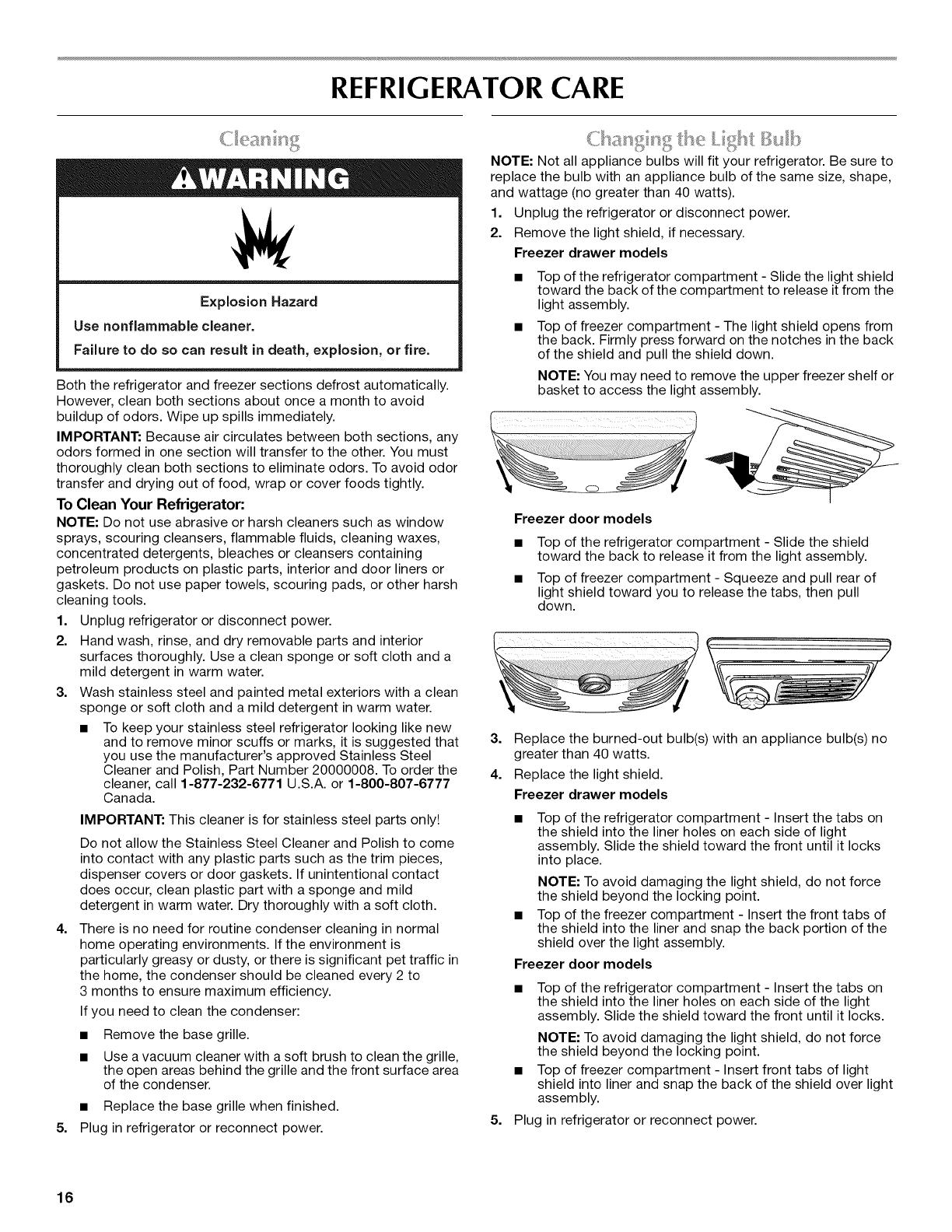
REFRIGERATOR CARE
Explosion Hazard
Use nonflammable cleaner.
Failure to do so can result in death, explosion, or fire.
Both the refrigerator and freezer sections defrost automatically.
However, clean both sections about once a month to avoid
buildup of odors. Wipe up spills immediately.
IMPORTANT: Because air circulates between both sections, any
odors formed in one section will transfer to the other. You must
thoroughly clean both sections to eliminate odors. To avoid odor
transfer and drying out of food, wrap or cover foods tightly.
To Clean Your Refrigerator:
NOTE: Do not use abrasive or harsh cleaners such as window
sprays, scouring cleansers, flammable fluids, cleaning waxes,
concentrated detergents, bleaches or cleansers containing
petroleum products on plastic parts, interior and door liners or
gaskets. Do not use paper towels, scouring pads, or other harsh
cleaning tools.
1. Unplug refrigerator or disconnect power.
2. Hand wash, rinse, and dry removable parts and interior
surfaces thoroughly. Use a clean sponge or soft cloth and a
mild detergent in warm water.
3. Wash stainless steel and painted metal exteriors with a clean
sponge or soft cloth and a mild detergent in warm water.
• To keep your stainless steel refrigerator looking like new
and to remove minor scuffs or marks, it is suggested that
you use the manufacturer's approved Stainless Steel
Cleaner and Polish, Part Number 20000008. To order the
cleaner, call 1-877-232-6771 U.S.A. or 1-800-807-6777
Canada.
4.
IMPORTANT: This cleaner is for stainless steel parts only!
Do not allow the Stainless Steel Cleaner and Polish to come
into contact with any plastic parts such as the trim pieces,
dispenser covers or door gaskets. If unintentional contact
does occur, clean plastic part with a sponge and mild
detergent in warm water. Dry thoroughly with a soft cloth.
There is no need for routine condenser cleaning in normal
home operating environments. If the environment is
particularly greasy or dusty, or there is significant pet traffic in
the home, the condenser should be cleaned every 2 to
3 months to ensure maximum efficiency.
If you need to clean the condenser:
• Remove the base grille.
• Use a vacuum cleaner with a soft brush to clean the grille,
the open areas behind the grille and the front surface area
of the condenser.
• Replace the base grille when finished.
5. Plug in refrigerator or reconnect power.
NOTE: Not all appliance bulbs will fit your refrigerator. Be sure to
replace the bulb with an appliance bulb of the same size, shape,
and wattage (no greater than 40 watts).
1. Unplug the refrigerator or disconnect power.
2. Remove the light shield, if necessary.
Freezer drawer models
Top of the refrigerator compartment - Slide the light shield
toward the back of the compartment to release it from the
light assembly.
Top of freezer compartment - The light shield opens from
the back. Firmly press forward on the notches in the back
of the shield and pull the shield down.
NOTE: You may need to remove the upper freezer shelf or
basket to access the light assembly.
Freezer door models
Top of the refrigerator compartment - Slide the shield
toward the back to release it from the light assembly.
Top of freezer compartment - Squeeze and pull rear of
light shield toward you to release the tabs, then pull
down.
3. Replace the burned-out bulb(s) with an appliance bulb(s) no
greater than 40 watts.
4. Replace the light shield.
Freezer drawer models
Top of the refrigerator compartment - Insert the tabs on
the shield into the liner holes on each side of light
assembly. Slide the shield toward the front until it locks
into place.
NOTE: To avoid damaging the light shield, do not force
the shield beyond the locking point.
Top of the freezer compartment - Insert the front tabs of
the shield into the liner and snap the back portion of the
shield over the light assembly.
Freezer door models
Top of the refrigerator compartment - Insert the tabs on
the shield into the liner holes on each side of the light
assembly. Slide the shield toward the front until it locks.
NOTE: To avoid damaging the light shield, do not force
the shield beyond the locking point.
Top of freezer compartment - Insert front tabs of light
shield into liner and snap the back of the shield over light
assembly.
5. Plug in refrigerator or reconnect power.
16



















